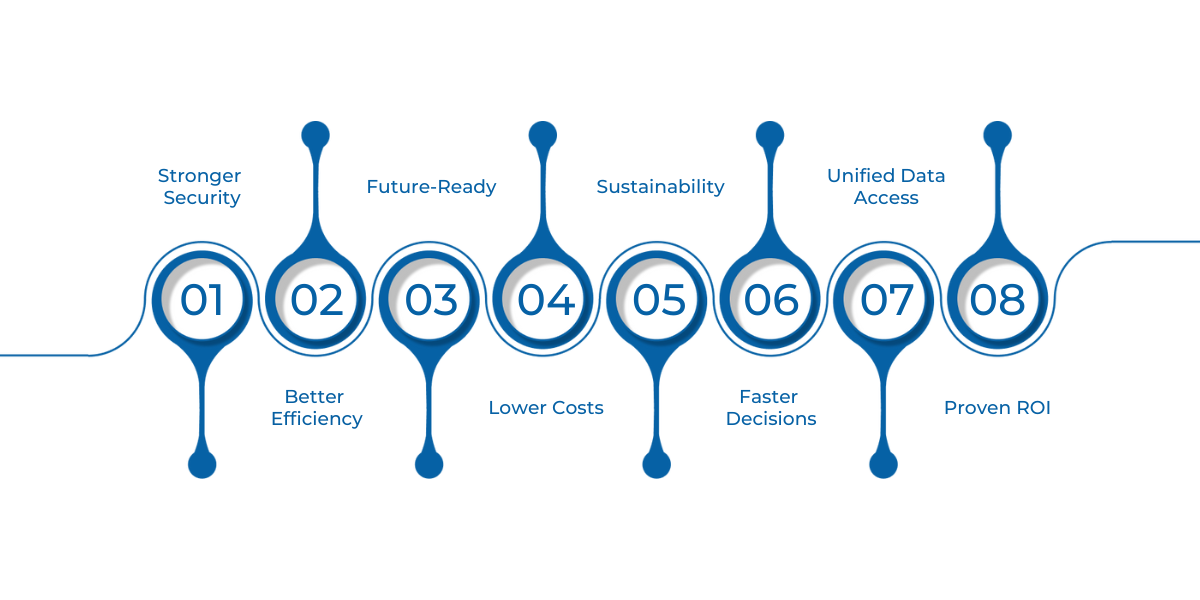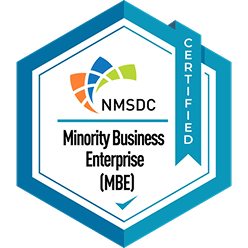

Modernizing your data estate allows organizations to transform fragmented legacy systems into a unified, scalable platform. This enables real-time analytics, secure data management, and faster, smarter decision-making across the enterprise.
In this blog, we’ll discuss the key benefits of modernizing your data estate, practical use cases, and how adopting modern data platforms can improve operational efficiency, enhance insights, and prepare your organization for future growth.
Before we explore the benefits, it’s important to understand what data estate modernization actually involves, so you can see how your systems can be upgraded for efficiency and growth.

Data estate modernization is the process of updating and optimizing an organization’s data infrastructure to handle growing volumes of data more efficiently.
It involves moving away from legacy systems and integrating modern tools such as cloud storage, data lakes, warehouses, and integration of AI-driven analytics platforms.
Below are the core components that make a modern data estate effective:
Example: A healthcare provider moved its patient records and operational data to a modern cloud platform. With unified access and real-time analytics, staff could spot trends in patient care faster, reduce errors, and improve outcomes.
With a clear understanding of the modernization process, the next step is to explore the key benefits of modernizing your data estate, showing why this investment pays off for businesses.

Below are the key features and benefits of modernizing your data estate:
Modern data estates use role-based access and advanced data security tools. This helps protect sensitive data and ensures compliance with rules like GDPR and HIPAA.
Automation reduces manual work, speeds up workflows, and makes managing data easier. Cloud-based systems scale as your data grows, so your business can handle more information without slowing down.
Modern platforms support AI and machine learning. This allows businesses to predict trends, make faster decisions, and create new opportunities.
New systems use less energy than old ones. This helps companies meet environmental goals while improving operations.
Real-time analytics and AI-powered insights provide accurate and up-to-date insights. Teams can act quickly on the data, improving performance and customer satisfaction.
Eliminates inconsistencies, integrates diverse sources (IoT, social media, ERP), and provides real-time, holistic business views.
Now that we’ve seen the benefits, let’s look at why moving from legacy systems to a modern data estate is critical, and how it transforms daily operations and strategic outcomes.
Modern businesses generate data at an unprecedented scale. Traditional systems often struggle with fragmented storage, slow reporting, and limited scalability, making it difficult for organizations to extract timely insights.
With cloud platforms, AI-driven analytics, and real-time data streams, the shift toward modern data environments has become a necessity rather than a choice.
To clearly understand this shift, let’s compare how traditional and modern data environments differ across critical aspects of business operations:
Also Read: Microsoft Synapse vs Fabric: Comprehensive Comparison
Having established the need for modernization, the following section outlines practical steps that delivers these benefits.

Modernizing your data estate helps businesses manage data more efficiently, make faster decisions, and stay competitive. To do this successfully, follow these steps:
Start by reviewing all your data sources, including databases, applications, and pipelines. Look for slow access, fragmented data, or inconsistencies.
Talk to teams across departments to understand workflow challenges and identify areas that need improvement.
Decide what you want to achieve with modernization. Create a clear roadmap and migration plan that fits your budget and timeline. Focus on improving data quality, analytics, and future readiness.
Roll out changes gradually. Begin with critical systems to minimize disruption. Learn from each phase to improve the next steps.
Make sure new tools and platforms work well with your existing systems. This helps maintain smooth operations and compliance with data rules.
Also Read: Thinking of Working with a Microsoft Fabric Partner? Here’s What to Expect
Next, it’s important to recognize the risks of modernization and strategies to address them, ensuring your data estate remains secure and cost-effective.

Modernizing your data estate is not just a technical upgrade, it’s a business necessity. Legacy systems often slow down innovation, increase costs, and expose organizations to compliance risks.
At the same time, a well-planned modernization strategy helps overcome these challenges, improve efficiency, and gain a competitive advantage.
Below are the key risks of neglecting data estate modernization and the strategies to address them:
Strategy: Conduct a full assessment of your infrastructure, quantify technical debt, and build a modernization roadmap that reallocates resources toward future-ready investments.
Businesses relying on outdated systems often miss real-time visibility, with many of them struggling to generate insights quickly enough to respond to market changes.
Strategy: Shift to cloud-based platforms with built-in scalability, IoT, and AI-driven analytics to deliver near real-time intelligence and faster decision-making.
Older systems make it harder to keep up with evolving standards like GDPR and HIPAA, leading to potential fines and reputational damage.
Strategy: Embed compliance checks early in the modernization process and adopt frameworks such as Microsoft’s Cloud Adoption Framework to ensure secure, regulation-ready operations.
Legacy infrastructures demand heavy manual intervention and high resource usage, driving costs disproportionately compared to value delivered.
Strategy: Use automation, serverless computing, and elastic scalability to streamline costs and align spending with actual business needs.
Organizations that delay modernization risk losing out to competitors who deliver faster insights, better customer experiences, and stronger resilience.
Strategy: Launch proof-of-concept pilots to test modern tools, engage cross-functional teams, and commit to continuous optimization for sustained competitiveness.
Also Read: Guide to Data Security and Privacy in Microsoft Fabric
Once we understand the risks and strategies, let’s explore modern data management best practices for building a secure, unified, and intelligent data estate.
Modern data management best practices help enterprises turn fragmented, siloed systems into unified, intelligent, and secure data estates.
By applying structured practices, businesses can improve agility, meet compliance needs, and gain faster insights.
Below are the best practices for modern data management:
Modernizing your data estate gives businesses a strong foundation for better decision-making, improved operational efficiency, and actionable insights.
As data volumes grow and the demand for real-time analytics rises, understanding why modernize your data estate is crucial for staying competitive and agile.
However, achieving these benefits requires careful planning, proper implementation, and strong governance to ensure security, scalability, and seamless integration across systems.
At WaferWire, we help organizations understand the complexities of modernizing their data estates, from cloud adoption to AI-driven analytics, ensuring optimal performance and measurable results.
Contact us today to start transforming your data estate into a modern, agile, and intelligent business asset.
1. Why is understanding the importance of modernizing your data estate crucial for businesses?
Modernizing your data estate enables unified data storage, real-time analytics, and AI integration, improving decision-making, operational efficiency, and competitiveness.
2. How does modernizing a data estate impact cost efficiency?
Upgrading to modern cloud-based systems reduces maintenance of legacy infrastructure, automates workflows, and optimizes resource usage, lowering overall operational costs.
3. What role does data governance play in modernizing a data estate?
Effective governance ensures data accuracy, compliance, and security, enabling organizations to trust their insights while minimizing regulatory and operational risks.
4. Can modernizing a data estate improve decision-making speed?
Yes, modern platforms provide real-time access to integrated data, allowing faster insights, agile responses to market changes, and data-driven strategies across teams.
5. What technologies support modern data estate modernization?
Cloud platforms, data lakes, warehouses, semantic layers, AI, and analytics tools are essential for transforming fragmented legacy systems into unified, scalable data environments.

